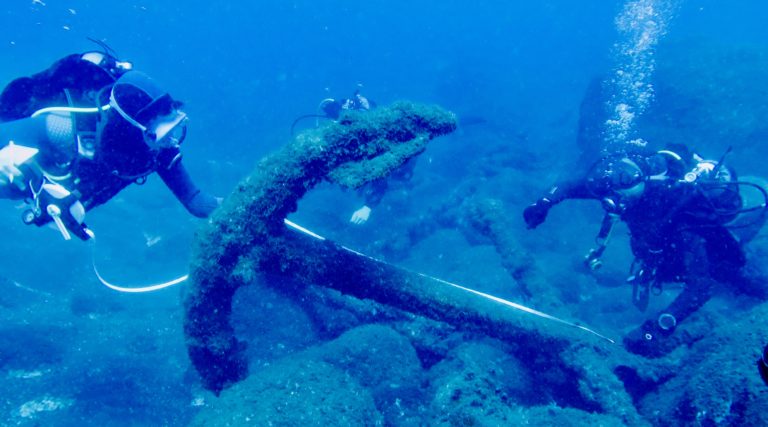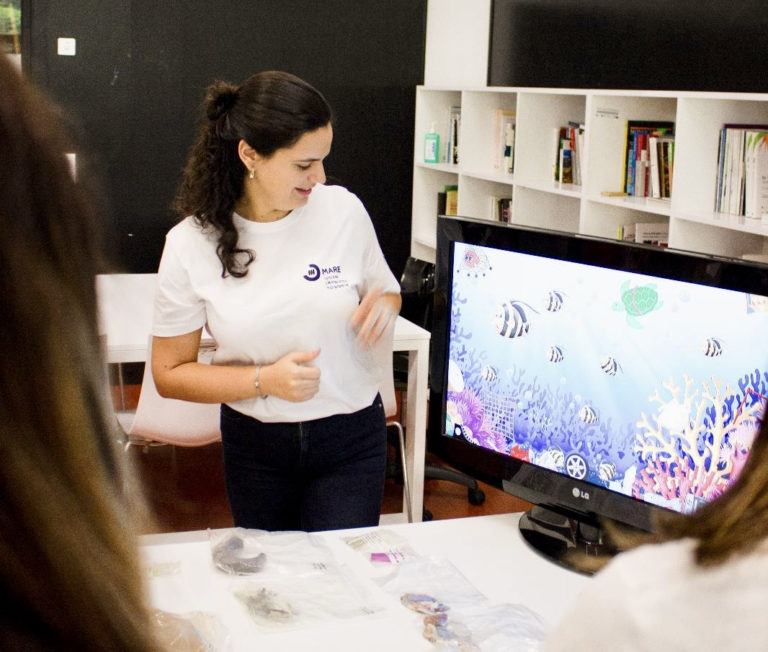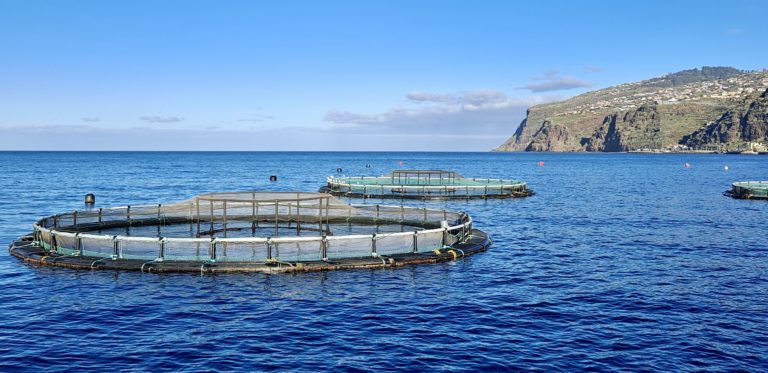We got the spirit, you got to hear it!
Insights into the soundscape ‘under the sea’

Pilot whale whistles and echolocation clicks, from Laura Redaelli’s research
Throughout the ages, Disney has created many a film that isn’t historically or scientifically accurate. The recently-released version of The Little Mermaid is no exception. Of the many fictional elements of this film you’ll no doubt have spotted if you took your children or just your incurably-ocean-loving-self to see it (e.g. that sharks are highly unlikely to burst through a shipwreck in pursuit of prey, for instance), there’s one thing that this movie gets scientifically spot-on: the ocean is a place alight with sound, harmony and highly-choreographed music.
When we on land think about the ocean’s sounds, most of us think of breaking waves. A few might also mention the lonely song of a humpback whale. But the ocean is awash with sound – countless frequencies, patterns and intensities are created by marine life to communicate, navigate, find prey and attract mates all the time in the ocean. Although few humans to date have the opportunity to regularly listen to and appreciate the performance, the live-action musical of the ocean is playing now and forever, in underwater theaters everywhere.
Sea critters have likely evolved to use sound so much because sound waves travel really well in water. In contrast to light, which travels slower in water than in air and is further hampered by the ocean’s multitude of suspended particles (visibility in very clear water might be 150-200m), sound waves travel around 5x faster in water than air. Much of aquatic life takes advantage of this efficiency by creating and being highly sensitive to sound.

Laura Redaelli deploying an acoustic recorder on a research trip
Laura Redaelli, one of our PhD students at MARE-Madeira, is focusing on sound for her PhD, and particularly those sounds from marine mammals. She is currently building an acoustic library of marine mammals around Madeira – the first of its kind for the island. Laura and our Marine Megafauna team regularly go out to collect acoustic data, pairing recordings from a hydrophone with sightings of species and their observed behaviors. This catalog can hopefully be used to profile sounds when acoustic data is collected independently of sightings, from acoustic recorders deployed in various locations around the Madeira archipelago.
Regularly recording calls and clicks from Madeira’s resident and migrating mammals, Laura gets an insight into the vast variety of sound these animals make. For the newcomer to this soundscape, Laura explains, “There are two big groups of whales, commonly known as toothed whales and baleen whales, and they have very different ways of communicating. Baleen whales produce these very low-frequency sounds, starting from a few hertz (Hz) that we can’t even hear (we hear sounds above 20 Hz) up to a few hundred Hz. Blue whales, for example, are around 20 Hz and we can’t hear them. So when I analyze their recordings, I have to speed up the sound to hear their calls.”
One of the cool features of baleen whales is that they can communicate over huge distances. “The lower the frequency, the farther sound travels, which means that some of the baleen whales can communicate over very, very long distances,” Laura says. Five hundred miles is well-recorded for a few species, with some studies suggesting that even a thousand miles is possible when these animals take advantage of a unique sound channel underwater.

Sperm whale social clicks (called codas), from Laura Redaelli’s research
“The other group is the toothed whales, which includes sperm whales, pilot whales, dolphins and relatives,” Laura continues. “They produce higher frequencies; we’re talking thousands of Hz. Some of them produce ultrasounds that we can’t hear either, because we can’t hear above 20,000 Hz. To listen to these recordings, I have to slow them down.”
One of the well-known sounds that toothed whales make are whistles, like those frequently associated with dolphins. These are their social calls. Something that some toothed whales can do that you might not know about is echolocation. “They send out narrow-band clicks that cover a huge frequency range over a very short time. They use these clicks to locate prey and navigate, listening for the backscatter of the sound to essentially get an acoustic image of what’s around them,” Laura explains. This is basically how naval sonar works.*
Most readers will likely be aware that whales and dolphins communicate by songs and whistles, but did you know that fishes make distinct calls, too? Enter Sebastian Muñoz, one of our collaborators who’s doing the International Master of Science in Marine Biological Resources (IMBRSea) and conducting research at the University of Lisbon. Similar to Laura, Sebastian is creating an acoustic catalog for Madeira, but his catalog is focusing on fish and the Mediterranean monk seal.

Recovering an underwater acoustic recorder (hydrophone). Photo provided by Sebastian Muñoz
Sebastian’s growing catalog of fish and seal recordings is the first attempt to characterize and create a library of these sounds in Madeira. “Madeira is a place with a lot of diversity in the ocean, which is very, very important. It’s the kind of environment, in the open sea, that can attract many species. It’s also home to one of the last remaining populations of Mediterranean monk seal, which is the most endangered seal species in the world,” he explains of his decision to focus his research here.
Stand alone, acoustic libraries add an important layer to our understanding of a species’ behaviors. But they also have important applications for wider research and conservation. “By doing this research, we can offer another way to monitor these species, to complement other sampling techniques,” Sebastian explains.
This sort of monitoring is known as Passive Acoustic Monitoring (PAM) and it has two key advantages. One, it’s non-invasive. If you know the sounds an animal makes, you don’t have to tag it or step into its environment to monitor it. This is great for conservation, as usually the less humans interfere with recovering wildlife, the better. Two, it’s cheaper. Leaving a hydrophone underwater for a few months costs far less than hiring SCUBA equipment or divers to monitor marine life over the same time period! Underwater video recordings are also more expensive (regarding equipment, energy and data-storage expense). Which means that, for marine research institutes like MARE-Madeira that are prioritizing low-cost research solutions, audio recordings are a real plus.**

Our in-house Marine Technology and AI team (Wave Labs) has also identified a third (potential) advantage of acoustic monitoring: ecotourism. Whale watching is a huge industry worldwide and is particularly popular in Portugal, accounting for about a quarter of European whale-watching revenues. In Madeira, regulations have been in place since 2013 and significant efforts have been made by companies here to make this activity as sustainable and respectful to the whales as possible. Whale watching in Madeira also greatly aids marine research: our long-standing relationships with whale-watching companies has helped us gathered important data on cetacean species — we’d know much less about these elusive animals without our whale-watching partners. As more tourists come to Madeira and these companies grow, however, they are faced with a dilemma: more tourists means more boats, which means more underwater sound and, potentially, more whales avoiding that sound. Growth in our whale-watching companies is important for Madeira’s economy, global ocean literacy and marine research, so the question is: what are the ways this industry can grow without creating more sound pollution? Marko Radeta, our Marine Technology and AI team leader, together with researchers from the University of Lisbon and the University of Madeira, has devised a possible, complementary solution for whale-watching companies: whale listening.
With our partners, we designed and developed an easy-to-use whale-listening app (Android, iOS) and a low-cost, lightweight hydrophone. We then trialed both in whale-watching tours. The result was great for both tourists and scientists, as we were able to collect valuable data from the whale-watching tourists and the tourists were able to hear the whales they were watching! It got great reviews. To our knowledge, this experiment was the first attempt to create a general-purpose system for collecting and streaming sounds while whale-watching. Although this system has only been used on-board whale-watching vessels to date, having a purely whale-listening alternative could help bring these animals to life to many more people on shore, costing less and reducing the amount of sound we collectively create in the ocean, too.

Images from our low-cost whale-listening app and hydrophone!
We’ll end this article on a positive note(!), but no discussion on ocean sound would be complete without properly acknowledging the wide range of sounds made by humans underwater, and their impacts. In a nutshell, the noise we add to the ocean soundscape reduces the range over which marine life can communicate, reduces their hearing abilities and negatively impacts their navigation. From mass strandings of beaked whales after naval sonar tests, to the reduced range of fin whales’ calls from 600 miles to 6 miles in heavily-trafficked waters, to beached dolphins showing significant hearing loss, studies repeatedly show that our underwater noise is impacting the sensing, communication and thus survival of these animals. Our noise also has a negative impact on our own industries, like fishing and tourism, as it can detract wildlife. “When there’s a lot of noise and animals figure out they can’t transmit messages, some will become silent. Others will move away,” Laura explains.
In this week’s Blue Economy and Sustainable Islands Forum, hosted by Island Innovation here in Madeira, we’re participating in a cross-stakeholder workshop to raise the challenge of sound management in the ocean. How can our underwater industries – those that aid important freight, energy and tourism industries – continue to grow without growing in underwater noise? Is it possible?
We hope you’ve enjoyed learning a little bit more about the sounds below the waves. May it inspire you to stick your head underwater when you’re next in the ocean and listen for a bit! No ticket needed, no Spotify subscription required, just take a deep breath and you can hear the real live-action version of ‘Under the Sea’. (Just maybe save the popcorn for later…)

*Learn more about the research we’re doing comparing the backscatter of plastics versus deep-sea squid species (an effort to understand why so many deep-diving whales fall victim to plastic ingestion) in this article: https://test.arditi.pt/choose-rugby-not-plastic/
** “Especially with our Wave team that has found ways to reduce the cost of recorders from a market price of around €2,000 to our in-house price of €100,” mentions João Pestana, our research technician.
Special thanks to Laura Redaelli, Sebastian Muñoz, João Pestana and Marko Radeta for their contributions to this article!
Learn more here!
Nunes, N J, Radeta, M, Nisi, V. (2020). Enhancing Whale Watching with Mobile Apps and Streaming Passive Acoustics. In: Nunes, N.J., Ma, L., Wang, M., Correia, N., Pan, Z. (eds) Entertainment Computing – ICEC 2020. ICEC 2020. Lecture Notes in Computer Science, vol 12523. Springer, Cham. https://doi.org/10.1007/978-3-030-65736-9_18
Radeta M, Nunes N, Vasconcelos D, Nisi V. (2018). POSEIDON – Passive-acoustic Ocean Sensor for Entertainment and Interactive Data-gathering in Opportunistic Nautical-activities. In Proceedings of the 2018 Designing Interactive Systems Conference (DIS ’18). Association for Computing Machinery, New York, NY, USA, 999–1011. https://doi.org/10.1145/3196709.3196752
Radeta et al. (2020). INTERAQUATICA-Designing Interactive Aquatic Experiences with Geodesic Domes In-the-Wild. In ACM International Conference on Interactive Media Experiences (pp. 170-173). https://doi.org/10.1145/3391614.3399395
Roberts, Callum. (2013). Ocean of life: how our seas are changing. London, Penguin.



